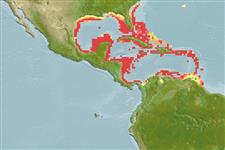Environment: milieu / climate zone / Tiefenbereich / distribution range
Ökologie
seewasser riff-verbunden; standorttreu; tiefenbereich 1 - 100 m (Ref. 110583), usually 15 - 55 m (Ref. 110583). Tropical; 33°N - 9°S, 98°W - 57°W
Western Atlantic: southern Florida and the western Gulf of Mexico to the West Indies-Caribbean region and Venezuela.
Size / Gewicht / Alter
Geschlechtsreife: Lm ? range ? - ? cm
Max length : 10.0 cm TL Männchen/unbestimmt; (Ref. 47838)
Rückenflossenstacheln (insgesamt) : 13 - 14; Rückenflossenweichstrahlen (insgesamt) : 18 - 19; Afterflossenstacheln: 3; Afterflossenweichstrahlen: 14 - 16. Upper half of body yellow-orange, shading into blackish basally in dorsal fin; lower half of body white; orange bands on head and a narrow orange bar on caudal peduncle (Ref. 13442).
Body shape (shape guide): short and / or deep; Cross section: compressed.
Inhabit deep coral-rich reefs and drop-offs (Ref. 47838). Feed on small invertebrates. Often seen nibbling on the tube feet of sea urchins or the tentacles of tubeworms (Ref. 9710). Unlike some chaetodonts it does not pick parasites from the bodies of other fishes (Ref. 5521). Solitary, sometimes in pairs (Ref. 47838). Seek refuge when approached (Ref. 47838). Oviparous (Ref. 205). Form pairs during breeding (Ref. 205).
Life cycle and mating behavior
Geschlechtsreife | Fortpflanzung | Ablaichen | Eier | Fecundity | Larven
Form pairs during breeding (Ref. 205).
Allen, G.R., R. Steene and M. Allen, 1998. A guide to angelfishes and butterflyfishes. Odyssey Publishing/Tropical Reef Research. 250 p. (Ref. 47838)
IUCN Rote Liste Status (Ref. 130435: Version 2025-1)
Bedrohung für Menschen
Harmless
Nutzung durch Menschen
Fischereien: kommerziell; Aquarium: Kommerziell
Tools
Zusatzinformationen
Download XML
Internet Quellen
Estimates based on models
Preferred temperature (Ref.
123201): 22.9 - 28, mean 26.5 °C (based on 234 cells).
Phylogenetic diversity index (Ref.
82804): PD
50 = 0.5001 [Uniqueness, from 0.5 = low to 2.0 = high].
Bayesian length-weight: a=0.02239 (0.01097 - 0.04568), b=3.01 (2.84 - 3.18), in cm total length, based on LWR estimates for this (Sub)family-body shape (Ref.
93245).
Trophic level (Ref.
69278): 3.4 ±0.2 se; based on diet studies.
Widerstandsfähigkeit (Ref.
120179): hoch, Verdopplung der Population dauert weniger als 15 Monate. (Preliminary K or Fecundity.).
Fishing Vulnerability (Ref.
59153): Low vulnerability (10 of 100).
🛈
Nutrients (Ref.
124155): Calcium = 146 [72, 247] mg/100g; Iron = 1.07 [0.60, 1.90] mg/100g; Protein = 18.5 [17.3, 19.8] %; Omega3 = 0.142 [0.074, 0.269] g/100g; Selenium = 45.9 [21.7, 93.2] μg/100g; VitaminA = 45.7 [12.3, 175.3] μg/100g; Zinc = 1.78 [1.15, 2.66] mg/100g (wet weight);
